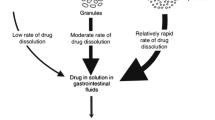Summary
Drug availability from solid dosage forms is usually determined by disintegration test methods. While the release of a drug from a compressed tablet is to some degree related to the speed of disintegration, there are many factors, such as particle size of the drug, the presence of adjuvants and variations in production methods, which Tender this in vitro method unreliable for accurate assessment of drug availability. It has been demonstrated that the dissolution rate of drug particles is of fundamental importance in determining the availability of the drug to the body. It is in fact, a rate-limiting Step in the absorption process when drugs are administered in solid dosage forms. Methods for the determination of dfssolution rates have been devised utilising mathematical models and in a number of instances quantitative correlation with in Vivo absorption has been demonstrated. Investigations are continuing to design generalised in vitro dissolution rate tests based on diffusional models which may be used for the quantitative assessment of drug availability from solid dosage forms.
Similar content being viewed by others
References
Dominguez, R. and Pomerene, E. 1945.Proc. Soc. Exptl. Biol. Med., 60, 173.
Nelson, E. 1959.J. Pharm. Sci., 48, 489; Ibid. (1960), 49, 437.
Wagner, J. G. and Nelson, E. 1963.J. Pharm. Sci., 52, 610.
Wagner, J. G. and Nelson, E. 1964. —, 53, 1392.
Oser, B. L.,et al. 1945.Ind. Eng. Chem. Anal. Chem. Ed., 17, 405.
Wagner, J. G.,et al. 1960.J. Pharmacol. Exptl. Therap., 129, 101.
Higuchi, T.,et al. 1955.J. Amer. Pharm. Ass. (Sci. Ed.) 44, 269.
Nelson, E. 1959.J. Pharm. Sci., 48, 96.
Nelson, E. and Schaldemose, I. 1959.J. Pharm. Sci., 48, 489.
Levy, G. 1961.J. Pharm. Sci., 50 388.
Wagner, J. G.,et al. 1962.J. Pharm. Sci., 51, 865.
Randeri, 1965.Dissertation Abstr., 25, 7212.
Marlow and Shangraw 1967.J. Pharm. Sci., 56, 498.
Levy, G. and Hollister, L. E. 1965.J. Pharm. Sci., 54, 1121.
Hixon, A. and Crowell, J. 1931.Ind. Eng. Chem., 23, 1923.
Higuchi, W. I. and Hiestand, E. N. 1963.J. Pharm. Sci., 52, 67.
—. 1963.J. Pharm. Sci., 52, 162.
Milosovitch, G. 1964.J. Pharm. Sci., 53, 484.
Schroeter, L. C. and Wagner, J. G. 1962.J. Pharm. Sci., 51, 957.
Rights and permissions
About this article
Cite this article
Timoney, R.F. Dissolution rate for predicting physiological availability of drugs from solid dosage forms. I. J. Med. Sc. 1, 79–82 (1968). https://doi.org/10.1007/BF02946441
Published:
Issue Date:
DOI: https://doi.org/10.1007/BF02946441




